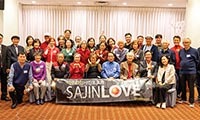Bubble Bursts in a Once-Roiling Market for Tea
China - Saudi Arabia has its oil. South Africa has its diamonds. And here in China’s temperate southwest, prosperity has come from the scrubby green tea trees that blanket the mountains of fabled Menghai County.
Over the past decade, as the nation went wild for the region’s brand of tea, known as Pu’er, farmers bought minivans, manufacturers became millionaires and Chinese citizens plowed their savings into black bricks of compacted Pu’er. But that was before the collapse of the tea market turned thousands of farmers and dealers into paupers and provided the nation with a very pungent lesson about gullibility, greed and the perils of the speculative bubble.
“Most of us are ruined,”said Fu Wei, one of the few traders to survive the implosion of the Pu’er market.“A lot of people behaved like idiots.”
A pleasantly aromatic beverage that promoters claim reduces cholesterol and cures hangovers, Pu’er became the darling of tea fanciers in recent years as this nation’s nouveaux riches embraced a distinctly Chinese way to display their wealth, and invest their savings. From 1999 to 2007, the price of Pu’er, a fermented brew invented by Tang Dynasty traders, increased tenfold, to a high of $330 a kilogram for the finest aged Pu’er, before tumbling far below its preboom levels.
“The saying around here was,‘It’s better to save Pu’er than to save money,’”said Wang Ruoyu, a longtime dealer in Xishuangbanna, the lush, tea-growing region of Yunnan Province that abuts the Burmese border.“Everyone thought they were going to get rich.”
Fermented tea was hardly the only investment frenzy that swept China during its boom years. The urban middle class speculated mainly in stock and real estate, pushing prices to stratospheric levels before exports slumped, growth slowed and hundreds of billions of dollars in paper profits disappeared over the past year.
In Yunnan, a cabal of manipulative buyers cornered the tea market and drove prices to record levels, giving some farmers and traders a taste of the country’s bubble? and its bitter aftermath.
At least a third of the 3,000 tea manufacturers and merchants have left the business. Farmers have begun replacing tea trees with staples like corn and rice. Here in Menghai, the newly opened six-story emporium built to house hundreds of buyers and bundlers is a very lonely place.
“Very few of us survived,”said Mr. Fu, 43, among the few tea traders brave enough to open a business in the complex. The rise and fall of Pu’er partly reflects the lack of investment opportunities and government oversight in rural Yunnan, as well as the abundance of cash among connoisseurs in the big cities.
Wu Xiduan, secretary general of the China Tea Marketing Association, said many naive investors had been taken in by the frenzied atmosphere, largely whipped up by out-of-town wholesalers .
He said that as farmers planted more tea, production doubled from 2006 to 2007, to more than 90,000 metric tons. In the final months, some producers shipped their tea to Yunnan from other provinces, labeled it Pu’er and enjoyed huge markups. When values hit absurd levels last spring, the buyers unloaded their stocks and disappeared.
With its near-mythic aura, Pu’er is well suited for hucksterism. It was supposedly invented by eighth-century horseback traders who compressed the tea leaves into cakes for easier transport.
Unlike other types of tea, which are consumed not long after harvest, Pu’er tastes better with age. Over the past decade, the industry has been shaped in ways that mirror the Western fetishization of wine. Enthusiasts talk about oxidation levels, loose-leaf versus compacted and whether the tea was harvested in the spring or the summer. (Spring tea, many believe, is more flavorful.)
But with no empirical way to establish a tea’s provenance, many buyers are easily duped.“If you study Pu’er your whole life, you still can’t recognize the differences in the teas,”said Mr.Wang, the tea buyer.“I tell people to just buy what tastes good.”
Among those most badly bruised by the crash are the farmers of Menghai County. Villagers built two-story brick homes, equipped them with televisions and refrigerators and sent their children to schools in the district capital.
“Everyone was wearing designer labels,”said Zhelu, 22, a farmer who is a member of the region’s Hani minority and uses only one name.“A lot of people bought cars, but now we can’t afford gas so we just park them.”
스마터리빙
more [ 건강]
[ 건강]이제 혈관 건강도 챙기자!
[현대해운]우리 눈에 보이지 않기 때문에 혈관 건강을 챙기는 것은 결코 쉽지 않은데요. 여러분은 혈관 건강을 유지하기 위해 어떤 노력을 하시나요?
 [ 건강]
[ 건강]내 몸이 건강해지는 과일궁합
 [ 라이프]
[ 라이프]벌레야 물럿거라! 천연 해충제 만들기
 [ 건강]
[ 건강]혈압 낮추는데 좋은 식품
[현대해운]혈관 건강은 주로 노화가 진행되면서 지켜야 할 문제라고 인식되어 왔습니다. 최근 생활 패턴과 식생활의 변화로 혈관의 노화 진행이 빨라지고
사람·사람들
more
“취미생활로 다진 친목… 선후배들과 만든 모교사랑”
사진러브한인 사진 동호회 사진러브(회장 크리스 고)는 13일 용수산에서 송년모임을 갖고 한 해를 마무리하는 뜻깊은 시간을 가졌다. 이날 모임에…

[홀인원] 이상원 박사
일반외과 전문의 이상원(왼쪽) 박사가 지난 9일 뉴포트비치 소재 골프장 9번 홀(152야드)에서 레스큐 클럽으로 친 샷이 그대로 홀에 빨려 들…
[송년행사 게시판] 재미시인협회
재미시인협회(회장 지성심)는 오는 20일 오후 4시 가든스윗호텔에서 한 해를 마무리하며 동인지 ‘외지’ 제35집 출판 기념회와 ‘제23회 재미…
[송년행사 게시판] 향군단체 연합
6.25 참전유공자회와 대한민국 육군협회 등 남가주 지역 향군 단체 연합은 19일 오전 11시30분, 용궁에서 송년 행사를 개최한다. 드레스코…
[송년행사 화보] “이웃과 함께 나누고 지인과 함…
KYCC13일 윌튼 플레이스 초등학교에서 열린 ‘한인타운청소년회관(KYCC) 홀리데이 카니발’이 성황리에 막을 내렸다. 올해는 KYCC 창립 …
많이 본 기사
- “1인당 2,000달러 환급금·세금 … 4
- 개명 하루만에 케네디센터 외벽에 ‘트럼프’ 추가…위법 논란도
- ‘유세방불’ 트럼프 “관세가 물가 올린다더니 인플레 수년來 최저”
- 구글, 검색결과 크롤링 업체 상대 소송…AI 경쟁사 견제 의도
- 해군, 트럼프 ‘황금함대’ 새 전함 발주… “외국조선사도 활용”
- 尹 소환한 김건희특검, ‘명태균 의혹’부터 6가지 혐의 순차 추궁
- 美, IS 무기고 등 70여곳 공습… “전쟁 시작 아닌 복수 선언”
- 법무부, ‘엡스타인문건’ 공개…정재계 추가 연루 증거 나올까
- 尹, 김건희특검 첫 출석…변호인 “아내 금품수수 몰랐다”
- 테라폼랩스 파산관재인, 테라 가격부양 금융사에 수조원대 소송
- ‘80세’ 선우용여, 대세 유튜브 수… 1
- ‘반이민 가속페달’⋯ 시민권자도 대거… 3
- ‘수퍼 독감’ 확산… 확진 4배 급증
- ‘테슬라 2018년 머스크 보상안’ 법원서 부활…1천400억달러 규모
- 故윤석화 빈소에 추모 발길… “하늘에서 좋은 작품 많이 하기를”
- 브라운대 총격 용의자 시신 발견… ‘… 1
- “박나래, 주사 이모 약에 내성 생겨..약 떨어지면 연락하라고”
- “트럼프, 강경화 대사에 ‘李대통령과 최고의 협력관계’ 언급”
- 李대통령 “재외국민 우편·전자투표 등 참정권 확대 방안 추진”
- 美, 베네수 마두로 압박 강화…처제·동서·조카 무더기 제재
- 트럼프, 화성은 미루고 달부터…머스크… 2
- LIRR 모바일 탑승권 탑승전 활성화해야
- 신민아♥김우빈, 결혼식 날 웨딩 사진 첫 공개..눈부신 투샷
- ‘김혜성도 넘었다’ 6년 120억 결… 1
- “개인 부동산 취득, 법카 사적 유용” 박수홍 친형 구속 이유 보니
- 한국타이어, 테네시공장 증설… 생산 두배로
- 센터빌 식당서 벌써 4% 부과 ‘말썽… 1
- 이 대통령, “불법촬영물, 초국가 범죄 대응본부 수사”
- “스페이스X, 상장 주관사 선정 착수…모건스탠리 유력”
- 동업자에서 채무자로..MC몽, 차가원… 1
- ‘통일교 의혹’ 전재수, 14시간여 마라톤 조사…혐의 전면 부인
- 트럼프 측근에 구글 창업자도…엡스타인… 1
- 시민권 박탈 착수⋯매달 200명 1
- 거주·투자용 한국 부동산 인기… 한인 유치 ‘치열’
- 팀스피릿 부동산그룹 송년모임
- 베네수엘라, 해군에 “유조선 호위하라”
- 대북제재 완화 시그널… 이 대통령, 통일부 역할 주문
- 루비오 국무장관 “韓·日 등 동맹과 약속 훼손 없이 中과 협력 모색”
- 북한군, 지난달 MDL 10번 넘었다
- 글로벌제약사 9곳 ‘약값 인하’ 동참…트럼프 “全미국인에 혜택”
- 재판서 드러난 통일교의 ‘큰그림’”청… 3
- 40·50대 은퇴, 자산은 있는데 확신은 없다
- 시신 훔쳐 팔아넘긴 부부 징역 중형 1
- “AI 보안으로 클라우드 시장 잡자”…구글, 100억 달러 보안 파트너십
- 뉴욕-뉴저지 다리· 터널 통행료 또 오른다
- [홀인원] 이상원 박사
- 대법 예규 후속절차, 22일 ‘형사부 증설’ 판사회의… 서울고법 ‘내란 전담재판부’ 설치 돌입
- 30년 만에 ‘금리 0.5%’ 허문 일본
- 기아 미국법인, 2026년형 ‘K4 … 1
- 뉴욕한인회 곽호수 이사장 ‘회장 판공비 논란’ 전격사임
1/5지식톡

-
 ☝️해외에서도 가능한 한국어 선생님…
0
☝️해외에서도 가능한 한국어 선생님…
0이 영상 하나면 충분합니다!♥️상담신청문의♥️☝️ 문의 폭주로 '선착순 상담'만 진행합니다.☎️ : 02-6213-9094✨카카오톡ID : @GOODEDU77 (@골뱅이 꼭 붙여주셔야합니다…
-
 테슬라 자동차 시트커버 장착
0
테슬라 자동차 시트커버 장착
0테슬라 시트커버, 사놓고 아직 못 씌우셨죠?장착이 생각보다 쉽지 않습니다.20년 경력 전문가에게 맡기세요 — 깔끔하고 딱 맞게 장착해드립니다!장착비용:앞좌석: $40뒷좌석: $60앞·뒷좌석 …
-
 식당용 부탄가스
0
식당용 부탄가스
0식당용 부탄가스 홀세일 합니다 로스앤젤레스 다운타운 픽업 가능 안녕 하세요?강아지 & 고양이 모든 애완동물 / 반려동물 식품 & 모든 애완동물/반려동물 관련 제품들 전문적으로 홀세일/취급하는 회사 입니다 100% …
-
 ACSL 국제 컴퓨터 과학 대회, …
0
ACSL 국제 컴퓨터 과학 대회, …
0웹사이트 : www.eduspot.co.kr 카카오톡 상담하기 : https://pf.kakao.com/_BEQWxb블로그 : https://blog.naver.com/eduspotmain안녕하세요, 에듀스팟입니다…
-
 바디프렌드 안마의자 창고 리퍼브 세…
0
바디프렌드 안마의자 창고 리퍼브 세…
0거의 새제품급 리퍼브 안마의자 대방출 한다고 합니다!8월 23일(토)…24일(일) 단 이틀!특가 판매가Famille: $500 ~ $1,000Falcon: $1,500 ~ $2,500픽업 & 배송직접 픽업 가능LA…
케이타운 1번가
오피니언
 한영일 / 서울경제 논설위원
한영일 / 서울경제 논설위원[만화경] 웰다잉 인센티브
 캐슬린 파커 워싱턴포스트 칼럼니스트
캐슬린 파커 워싱턴포스트 칼럼니스트 [캐슬린 파커 칼럼] 아이들을 온라인에서 보호하기
 양상훈 수필가ㆍ시인
양상훈 수필가ㆍ시인 [한국춘추] 경제대공황ㆍ제2차 세계대전 승리로 극복한 루스벨트 리더쉽

[왈가 왈부] 고환율에 외환 건전성 완화·서학개미 규제… 미봉책 아닌가요
 수잔 최 한미가정상담소 이사장 가정법 전문 변호사
수잔 최 한미가정상담소 이사장 가정법 전문 변호사 [수잔 최 변호사의 LIFE &] AI 시대 편리함에 안주하지 말자
 김도년 성균관대 건축학과 교수 스마트도시·건축학회장
김도년 성균관대 건축학과 교수 스마트도시·건축학회장 [로터리] 지멘스가 만드는 미래 동네
1/3지사별 뉴스

퀸즈장로교회 ‘사랑의 바구니’130개 이웃에 전달
퀸즈장로교회가 18일 크리스마스를 앞두고 교인들의 정성과 사랑이 듬뿍 담긴 ‘사랑의 바구니’ 130개를 소방서와 경찰서, 요양원, 선교회, 그…
시민권 박탈 착수⋯매달 200명

“이웃 돌보는 여러분이 동역자”
워싱턴성광교회(담임목사 임용우)는 18일 한인단체와 소방서‧도서관 등에 총 2만9천 달러의 성금을 전달했다. 지난 2011년부터 15년째 지역…
소기업 지원에 1천만 달러 투자

위기의 트럼프 “내년봄 최대규모 세금환급”
트럼프 대통령은 17일 “취임 1년 만에 우리는 누구도 상상하지 못한 성과를 이뤄냈다”고 말했다.트럼프 대통령은 동부시간 이날 밤 9시부터 백…
[새해부터 이렇게 달라진다] 최저임금 또 오르고… 유급 병가는 더 확대

오늘 하루 이 창 열지 않음 닫기 




















































.png)


댓글 안에 당신의 성숙함도 담아 주세요.
'오늘의 한마디'는 기사에 대하여 자신의 생각을 말하고 남의 생각을 들으며 서로 다양한 의견을 나누는 공간입니다. 그러나 간혹 불건전한 내용을 올리시는 분들이 계셔서 건전한 인터넷문화 정착을 위해 아래와 같은 운영원칙을 적용합니다.
자체 모니터링을 통해 아래에 해당하는 내용이 포함된 댓글이 발견되면 예고없이 삭제 조치를 하겠습니다.
불건전한 댓글을 올리거나, 이름에 비속어 및 상대방의 불쾌감을 주는 단어를 사용, 유명인 또는 특정 일반인을 사칭하는 경우 이용에 대한 차단 제재를 받을 수 있습니다. 차단될 경우, 일주일간 댓글을 달수 없게 됩니다.
명예훼손, 개인정보 유출, 욕설 등 법률에 위반되는 댓글은 관계 법령에 의거 민형사상 처벌을 받을 수 있으니 이용에 주의를 부탁드립니다.
Close
x